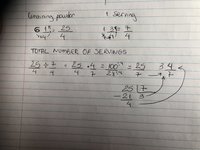Hello,
Question: The amount of hot cocoa powder remaining in a can is 6 1/4 tablespoons. A single serving consists of 1 3/4 tablespoons of the powder. What is the total number of servings of the powder remaining in the can?
How do I solve it?
The answer is 3 4/7
Thanks
Question: The amount of hot cocoa powder remaining in a can is 6 1/4 tablespoons. A single serving consists of 1 3/4 tablespoons of the powder. What is the total number of servings of the powder remaining in the can?
How do I solve it?
The answer is 3 4/7
Thanks

